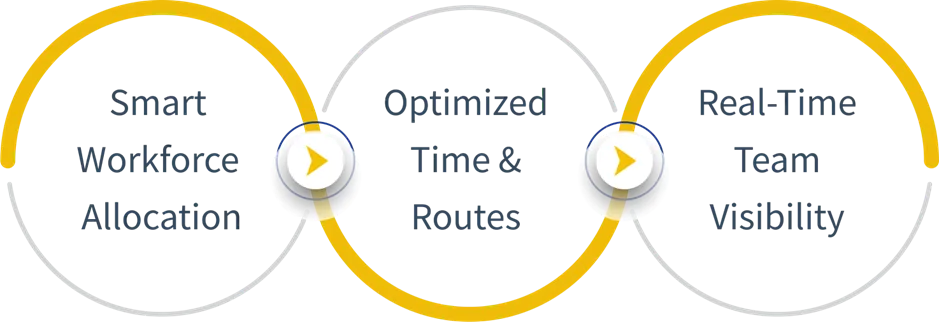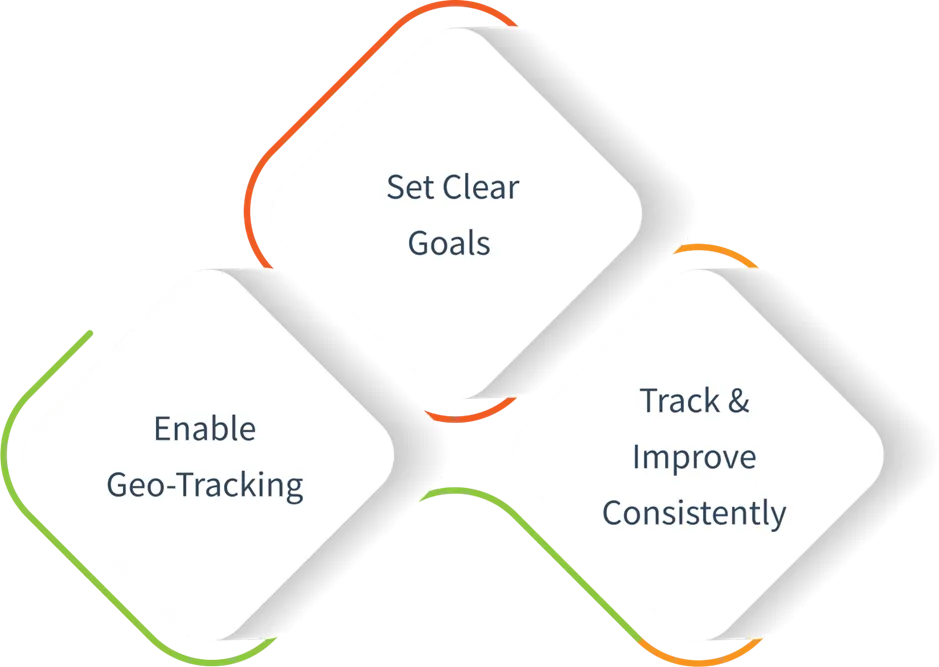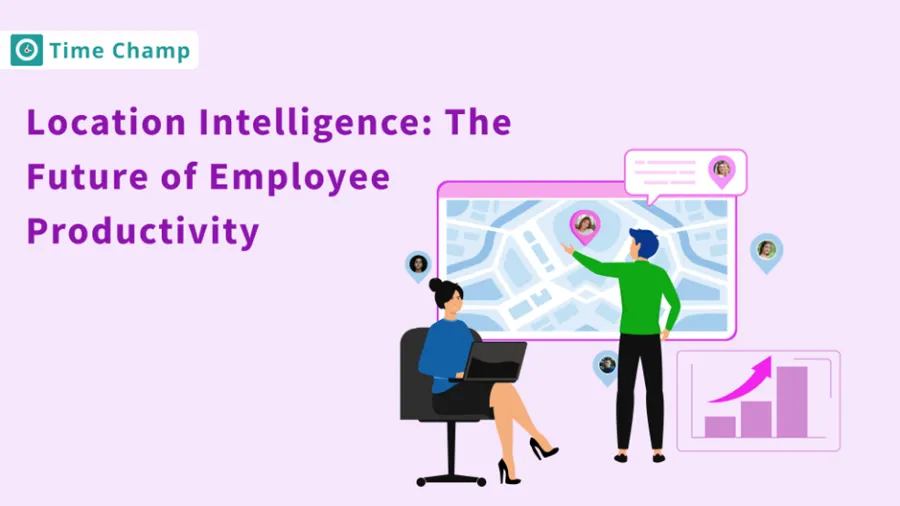In the era where remote work, hybrid schedules, and field operations are becoming the new normal, productivity monitoring is not limited to the office desk. Location intelligence is how modern businesses are getting a real-time visibility into where their teams are and how effectively they are doing their job and how their operations can be optimized. This smart solution has nothing to do with surveillance, it is all about giving managers and HR teams the possibility to make informed decisions using accurate, location-based insights.
From field employee monitoring to hybrid work optimization, location-based intelligence platforms are transforming workforce analytics. This blog helps you understand how location intelligence works, values it brings to your organization, and how it can shape the future of your team’s productivity.
What is Location Intelligence?
Location Intelligence (LI) is the collection, analysis and visualization of location-based data to find location-based patterns, trends and insights. Location intelligence can help organisations to make informed decisions and enhance business performance by combining geographical context using business, demographic or behavioural information. It allows companies to get to know where the action takes place, why it takes place there, and what to do about it.
Using both GPS tracking, mobile check-ins and geofencing, location intelligence platforms can visualize movements, optimize routing and help in more intelligent resource planning. Much more than the mere monitoring feature, LI provides HR professionals and team leads with actionable data that facilitates productivity, safety, and performance of remote, hybrid, and field workforce teams.
It is not simply logical to track where the employees are, but to be conscious of why that matters to business success.
How Location Intelligence Works in Workforce
Location intelligence converts the raw location information into actionable insights that can enable you to manage your workforce in a more effective manner. It can give a clear image of where and how the employees work, in-office, remote, or field, as it can be integrated with other technologies. This makes decision-making smarter when it comes to task planning, travel routes, shift scheduling, and productivity tracking.
Here is how it works in a real-world work environment:
Location Data Sources in Work Environments
Location intelligence is based on various types of sources to develop a real-time picture of the workforce presence. These include:
- Mobile phone or company tracking using GPS.
- Bluetooth or Wi-Fi beacons that are in offices.
- Attendance apps or employee portal check-ins.
- Geotagged timestamps during job-related tasks.
- The use of geofencing in work areas.
Such inputs are tracked into location intelligence systems, whereby data are centralised and analysed. Consequently, managers receive a trustworthy and uninterrupted flow of location-based insights, which is critical to contemporary workforce planning.
Visualizing and Analysing Workforce Movements
After collecting the data, the next step that one can do is to interpret the data. Visualization tools such as interactive maps, heatmaps, dashboards, etc., allow you to follow the progress in locations, and shifts.
With this visibility you can:
- Identify field inefficiencies or bottlenecks.
- Determine successful teams in terms of time and location patterns.
- Minimize the travel routes to save gas and time.
- Recognize abnormalities or deviations from expected routines.
With the help of these patterns, an evidence-based decision can be taken by the organization to help in overall productivity, cut all unwanted travel and help the organizations promote employee accountability.
Business Benefits of Location Intelligence
Location intelligence does not simply track but also serves as a powerful strategic tool capable of helping you make more intelligent decisions, boosting employee efficiency and improving the efficiency of operating processes. This is how it helps you in your workforce management:

Streamlines Workforce Allocation
The ability to know the real-time location and availability of employees allows you to assign work more efficiently based on proximity, workload and urgency. This will guarantee that the right people are in the right place at the right time, and thus there is less idle time, and this will also increase the response rate, particularly in fast-paced or field-intensive environments.
Time Optimization & Route Efficiency
Location intelligence can be used in the optimization of field team routes based on travel patterns and where the job is to be located. This means:
- Less time spent on commuting and to accomplish the work.
- Reduced fuel prices.
- Less traffic and ineffective routing delays.
The smart routing leads to a productivity increase and cost reduction particularly where companies have logistics, delivery or service departments.
Enhances Field Employee Visibility
Conventional workforce tools do not always perform well when it comes to field operations. Location intelligence seals this gap, providing you with current information on the location of your mobile employees and what they are doing. It encourages accountability, builds trust, and enables the managers to help the teams in advance, without micromanaging.
Real-World Use Cases of Location Intelligence
The practical uses of location intelligence are numerous, as it can be applied to all kinds of business models, maybe even from the management of hybrid teams to keeping an eye on the field operations of enterprises. Here are some key scenarios where it can make a significant impact:
Hybrid Work Monitoring
The handling of hybrid teams is associated with challenges, such as understanding who is working where, when, and how effectively. With location intelligence:
- HR teams can track employee check-ins, both remotely and on-site.
- The managers will be able to guarantee fair rotation schedules and balanced space utilization.
- Leaders gain valuable insights to assess how hybrid work models impact team productivity.
It helps in reducing the visibility gap between the remote and the in-office employees and provides flexibility.
On-the-Go Sales & Service Teams
Location intelligence can make all the difference in businesses that have mobile teams such as sales reps, technicians or delivery agents. It enables you to:
- Track real-time movements and route status.
- Immediately respond to changing schedules.
- Field visit and task completions validate to geotagged data.
This results in increased accountability, quick response rates and customer service.
Remote Attendance & Geo-Fencing
In geo-fencing, it is possible to create virtual boundaries around certain job sites. There is no manual checking in, as employees are automatically checked in as they go inside the zone. Geo-fencing functionality like this:
- Minimizes attendance fraud or proxy logins.
- Helps in monitoring project-wise hours and site-specific labour.
- Makes sure the regulated industries are compliant.
It is a smart way to coordinate a distributed team to multiple sites with minimum administrative burden.
The Future of Workforce Location Intelligence
The workforce location intelligence is also developing at a tremendous pace as the trend towards hybrid work, mobile work models, and the need to operate in real time are emerging. With companies in search of smarter methods of collaboration with distributed teams, location intelligence tools are not optional anymore.
The following developments are important:
- Location analytics that allow optimized scheduling and planning using AI.
- Integration with wearable technology provides safety and task efficiency for the employees.
- Data use and trust are to be balanced with privacy-first employee location tracking.
- Easy integration with comprehensive workforce analytics platforms to view insights in a system.
These trends indicate that we will see a day when businesses will not only monitor the location of employees, but they will also use location-based intelligence to design smarter, more agile, and more empowered teams.
How to Get Started with Location Intelligence
Integrating location intelligence solutions should not be complicated. By using the appropriate strategy and tools, you can easily unlock insights that will provide workforce efficiency and more smarter decision-making. Here is how to begin:

Set Clear Goals
It is important to define what you would like to accomplish before employing any location intelligence platform. Ask yourself:
- Would you like to enhance field team visibility?
- Do you want to monitor hybrid staff attendance?
- Do you want to minimize the travel time or expenses?
Clearly defined goals will make sure that your location intelligence platform is aligned with your business needs. It is whether real-time workforce tracking or geo-fencing specific locations; clarity can allow you to track your success and results.
Configure Geo-Tracking
Location intelligence is not a one-time setup; it becomes more useful the more you use it. Once you configure geo-tracking in Time Champ, turn the new location insights received into a continuous process of optimization:
- Track live dashboards: Time Champ provides in real-time map and heat-maps of who is present where, who is in transit and how long operations actually take. Quick visuals enable managers to see at a glance when things are delayed or unproductive.
- Analyze trends in workforce analytics: Monthly or weekly reports show trends, such as frequent traffic jams, heavily overtime sites or high performers who complete routes more quickly. These workforce location intelligence metrics will help you to optimize schedules as well as territories.
- Run data-driven experiments: Simply change the shift start times, re-route field team routes or alter geo-fence sizes, and compare the outcomes within your location intelligence dashboards within Time Champ. Minute changes will reduce the number of travel miles and increase service response.
- Close the loop with feedback: Share experiences with the workers, share about efficient routes, have discussions on delays and come to an agreeable solution. The clear data creates credibility and keeps everyone concerned in the smarter, location-dependent process.
Through regular review and correction, you can turn raw GPS pings into location intelligence data that you can act on to turn every insight into greater productivity, reduced expenses, and a continuously improving workforce.
Monitor & Improve Continuously
The location intelligence is the most valuable when followed on a regular basis. Using Time Champ real-time dashboards, you are able to track employees while they are moving, detect delays and uncover high-performance routes or teams.
Use location insights to:
- Identify travel inefficiencies and time delays.
- Rotate shifts or routes based on insights.
- Identify top performers with the help of location intelligence data.
Keeping an eye on trends and comparing locations over time allows you to make significant changes to how your teams operate and transform location data into a critical success factor to your workforce.
Conclusion
Location intelligence is no longer a tech trend alone, but strategic advantage. Through the real-time location, organizations will know how, when, and where employees are working so that they are able to make quick decisions, greater productivity and be able to maintain stronger over remote and field operations. It makes the transition between assuming to insightful and empowered by the intelligent workforce management.
When it comes to managing attendance, route optimization or improving hybrid visibility, a location-based intelligence platform such as Time Champ puts you ahead of the curve. It is not about surveillance, but about empowering teams, enhancing accountability and clarity. With the changing nature of the workplace, location intelligence keeps your team flexible, productive and future proof.
Frequently Asked Questions
Yes, employee location tracking is legal in many regions when done transparently and with consent. It’s important to inform employees about how their location data is used and ensure compliance with local labour and privacy laws.
Not at all. Small and medium-sized businesses also benefit from location intelligence for managing distributed teams, improving field operations, and reducing manual oversight making it a scalable solution for any workforce size.
Yes, many location-based intelligence platforms offer integration with HRMS, payroll, and attendance tools. This allows automatic syncing of location-stamped work hours, simplifying payroll processing and compliance tracking.
Yes, many platforms, including Time Champ, support offline tracking. Data is stored locally and automatically syncs once the device regains internet connectivity, ensuring uninterrupted data collection even in remote areas.








